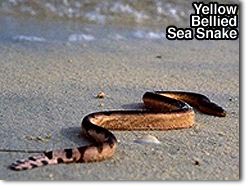Sea Snakes
 Sea snakes occur throughout the UAE sea area. There are at least seven species, all of which belong to one family, the Hydrophiidae. They are excellent swimmers and the laterally flattened tail makes them easily recognisable and distinguishes them from eels, such as the harmless yellow and black banded snake eels that often feed in sandy seabeds in UAE waters, but are rarely seen on the surface alive. Sea snakes are most abundant in the warm shallow seas of the Arabian Gulf, where they are frequently seen resting motionless on the sea's surface. The striking bright yellow and black bands of the Arabian Gulf sea snake (Hydrophis lapemoides ) catch the eye against a sea of turquoise blue and draw a cautious curiosity among on-looking boaters. Often the snakes too show their natural curiosity, raising their small heads up to two feet above the water to eye the surface surroundings and directly approaching a stationary craft. The seemingly unmistakable pattern of the Arabian Gulf sea snake is in fact shared by a number of other species which can easily be confused. The annulated sea snake ( H. cyanocynctus ) is very similar and both the yellow sea snake (H. spiralis ) and Shaw's sea snake (Lapemis curtus ) could be mistaken for either. The first two are generally fairly large and bulky, reaching lengths of over a metre, but not as large as the yellow sea snake which can easily exceed 2 m. Confusingly, the colour varies among them from yellow to green to grey and the black banding too is variable in extent and shade. In Shaw's sea snake the bands often take on a rough diamond shape, thicker over the spine and converging to points at the flanks. The yellow-bellied sea snake (Pelamis platurus ) is one of few that is easily recognisable being uniform brown above and yellowish on the undersides with the black tail baring a bold yellow pattern. Sea snakes occur throughout the UAE sea area. There are at least seven species, all of which belong to one family, the Hydrophiidae. They are excellent swimmers and the laterally flattened tail makes them easily recognisable and distinguishes them from eels, such as the harmless yellow and black banded snake eels that often feed in sandy seabeds in UAE waters, but are rarely seen on the surface alive. Sea snakes are most abundant in the warm shallow seas of the Arabian Gulf, where they are frequently seen resting motionless on the sea's surface. The striking bright yellow and black bands of the Arabian Gulf sea snake (Hydrophis lapemoides ) catch the eye against a sea of turquoise blue and draw a cautious curiosity among on-looking boaters. Often the snakes too show their natural curiosity, raising their small heads up to two feet above the water to eye the surface surroundings and directly approaching a stationary craft. The seemingly unmistakable pattern of the Arabian Gulf sea snake is in fact shared by a number of other species which can easily be confused. The annulated sea snake ( H. cyanocynctus ) is very similar and both the yellow sea snake (H. spiralis ) and Shaw's sea snake (Lapemis curtus ) could be mistaken for either. The first two are generally fairly large and bulky, reaching lengths of over a metre, but not as large as the yellow sea snake which can easily exceed 2 m. Confusingly, the colour varies among them from yellow to green to grey and the black banding too is variable in extent and shade. In Shaw's sea snake the bands often take on a rough diamond shape, thicker over the spine and converging to points at the flanks. The yellow-bellied sea snake (Pelamis platurus ) is one of few that is easily recognisable being uniform brown above and yellowish on the undersides with the black tail baring a bold yellow pattern.
Are they dangerous?
It is not uncommon to find a live sea snake washed ashore, or left stranded on the beach by a rapidly falling tide. Unable to move, they must wait for the high tide in order to return to their watery world. A sea snake lying motionless on a beach may appear dead, but it is wise to resist any temptation to handle such specimens, for they could well be alive. Although not aggressive, unwanted handling may provoke an attack.
Sea snakes are the most venomous of the world's snakes. One drop of sea snake venom is reputed to have the potency to kill five men. This high toxicity enables them to disable their cold-blooded prey, such as fish, crabs and squid on which they feed. Even young sea snakes, that are born live at sea, have a venom as potent as any adult.
People are rarely bitten by sea snakes. Their apparently docile nature largely precludes the chance of a deliberate sea snake attack and they are anyway generally recognised as dangerous and avoided. The small mouth restricts their ability to bite any but the smallest appendage, such as a finger, although the gape can be greatly extended. Fishermen in the UAE are sometimes struck, having unintentionally angered a sea snake by hauling one into a boat in a fishing net. One of the first signs of the venom acting on a victim is a difficulty in breathing and swallowing, aching muscles and drooping eyelids. Although undoubtedly very dangerous, sea snakes, like all snakes, do not necessarily inject venom at each bite and symptoms of shock are often misidentified as serious snake bite cases.
|